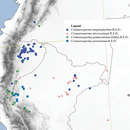Description
provided by Phytokeys
Tree 4–15 m tall, 8–15 cm diam.; young twigs and petioles glabrous. Leaves: petioles 4–15 by 1–3 mm; lamina elliptic to obovate or narrowly so, 12–27 by 4–10 cm (index 2–3.6), chartaceous, (dark) greyish-brown above, blackish-brown with darker veins below, glabrous above, glabrous to sparsely covered with appressed golden hairs to 0.6 mm long, particularly on veins below, base acute to rounded, decurrent, apex acuminate (acumen 5–20 mm long), primary vein 1.5–2.5 mm wide at widest point, secondary veins 7–13, intersecondary veins often 1–3, distance between from 5 mm at the base to 15–20 mm closer to the apex, angles with primary vein inconsistent, 40–60° at the base and closer to the apex, not branching, forming distinct loops, smallest distance between loops and margin 1–4 mm, tertiary veins more or less percurrent. Inflorescence of single flowers clustered in groups of up to 2, on leafy or leafless twigs or main trunk; peduncles 2–10 by ca. 1 mm (in flower), 5–15 by ca. 1.5 mm (in fruit), sparsely to rather densely covered with appressed golden or whitish hairs 0.1–0.4 mm long; pedicels (30–)35–75(–95) by ca. 1 mm at the base, to 3 mm at the apex (in flower), (30–)55–85(–110) by 1–1.5 mm at the base, to 3 mm at the apex (in fruit), sparsely to rather densely (at the base) covered with appressed golden or whitish hairs 0.1- 0.4 mm long or glabrous; 1-several lower bracts, elliptic, ca. 1.5 by 1 mm, acute, soon falling off, sparsely to rather densely covered with appressed golden or whitish hairs 0.1- 0.4 mm long; upper bract attached in variable position on pedicel, ovate to very broadly ovate, 1–2.5 by 1–2 mm, acute, obtuse or rounded, sparsely to rather densely covered with appressed golden or whitish hairs 0.1- 0.4 mm long or glabrous; closed flower buds very broadly ovoid to globose, opening loosely in development; flowers green, maturing to green-violet, yellow or pale cream-yellow, inner petals with purple base in vivo, dark brown or reddish-brown in sicco, sepals and petals glabrous; sepals free or connate for ca. 1 mm, broadly to very broadly ovate or broadly ovate-triangular, appressed, patent or recurved, 2.5–4 by 2.5–4 mm, obtuse, mostly persistent; outer petals elliptic to broadly elliptic, 11–17 by 7–13 mm, inner petals elliptic, obovate or narrowly so, 11–19 by 4–8 mm, obtuse or rounded, petals with prominent venation; androecium ca. 7 mm diam., stamens 1.3–1.8 mm long, connective appendage 0.5–0.8 mm wide; gynoecium ca. 1.5 mm diam., carpels 2–2.2 mm long. Monocarps 3–27, ellipsoid to broadly ellipsoid, asymmetrical, 12–17 by 10–12 mm, green (immature) in vivo, black, dark brown or reddish-brown in sicco, with an excentric apicule; stipes 11–21 by 1.5–2 mm; fruiting receptacle 4–10 mm diam.; monocarps, stipes and receptacle glabrous. Seeds ellipsoid to broadly ellipsoid, reddish-brown, pitted, ca. 10 by 7 mm, raphe sunken, regular.
- license
- cc-by-3.0
- copyright
- Michael D. Pirie, Lars W. Chatrou, Paul J. M. Maas
- bibliographic citation
- Pirie M, Chatrou L, Maas P (2018) A taxonomic revision of the Neotropical genus Cremastosperma (Annonaceae), including five new species PhytoKeys (112): 1–141
- author
- Michael D. Pirie
- author
- Lars W. Chatrou
- author
- Paul J. M. Maas
Distribution
provided by Phytokeys
Ecuador (Zamora-Chinchipe), Peru (San Martín, Cajamarca). Two collections of less certain affinity have been made further north in Ecuador (Pastaza, Morona-Santiago) and one in Colombia (Caquetá).
- license
- cc-by-3.0
- copyright
- Michael D. Pirie, Lars W. Chatrou, Paul J. M. Maas
- bibliographic citation
- Pirie M, Chatrou L, Maas P (2018) A taxonomic revision of the Neotropical genus Cremastosperma (Annonaceae), including five new species PhytoKeys (112): 1–141
- author
- Michael D. Pirie
- author
- Lars W. Chatrou
- author
- Paul J. M. Maas

